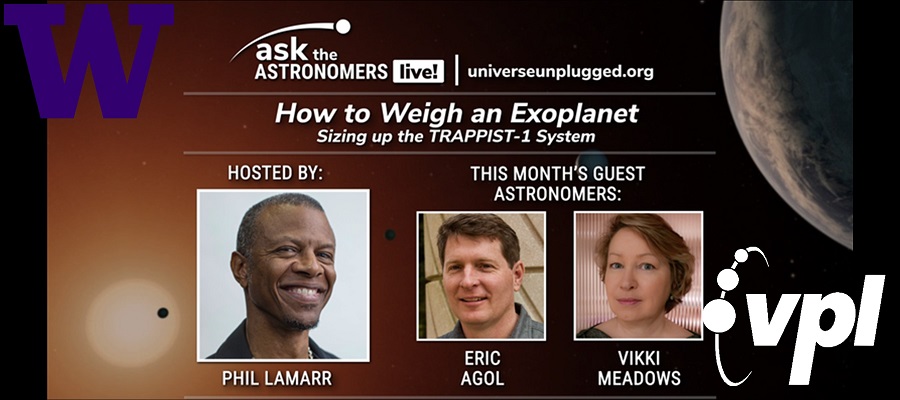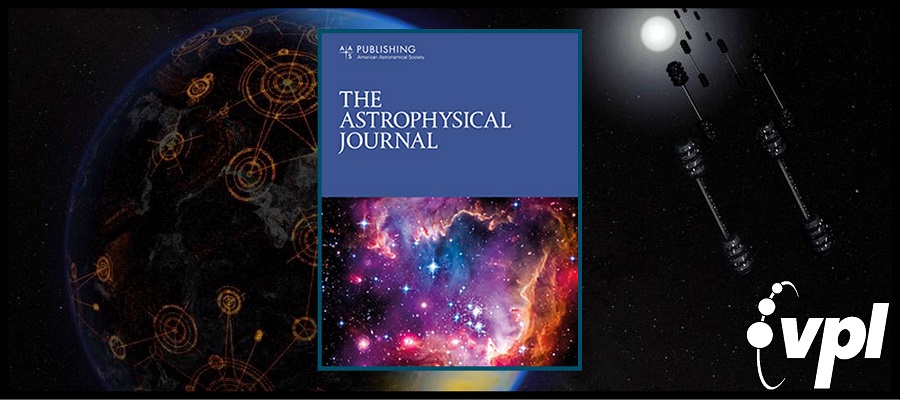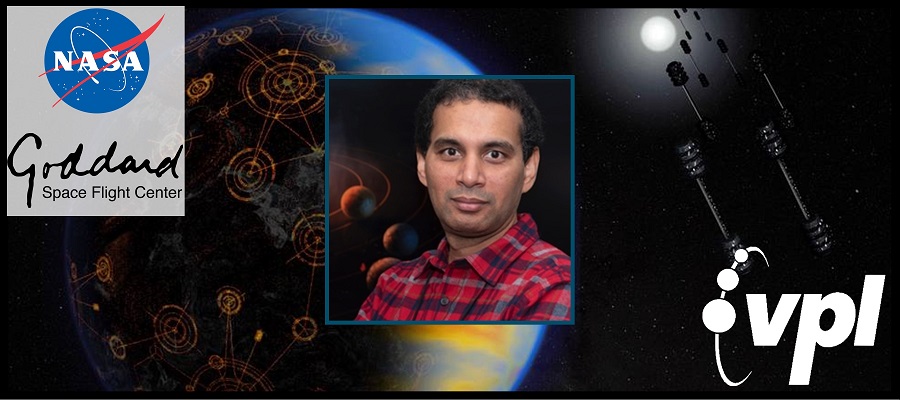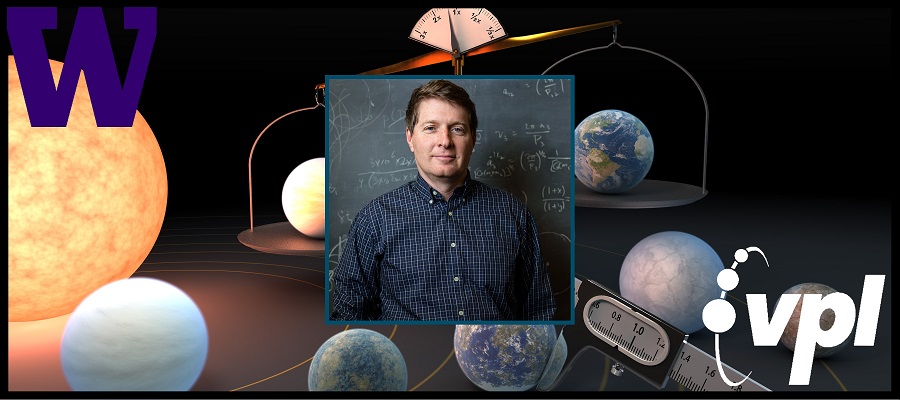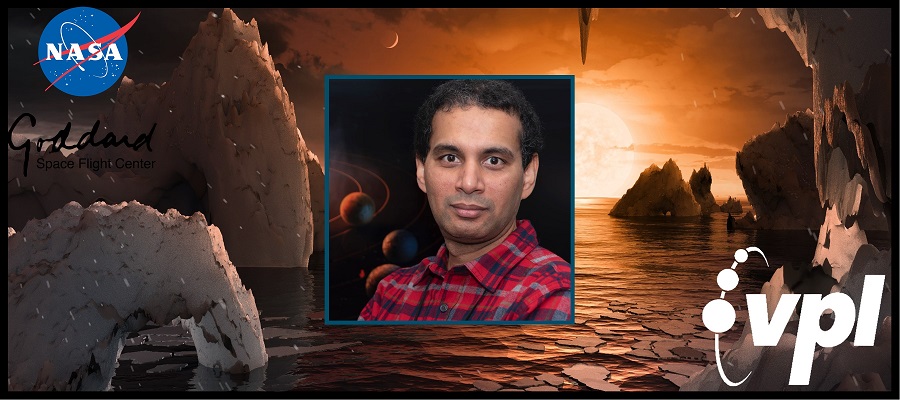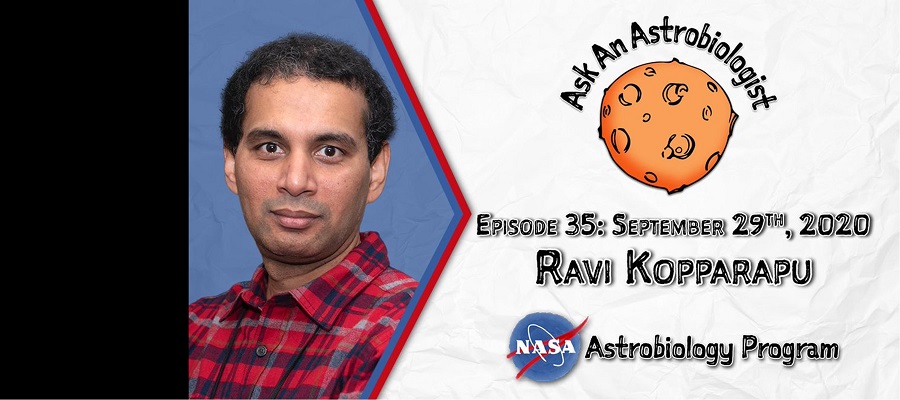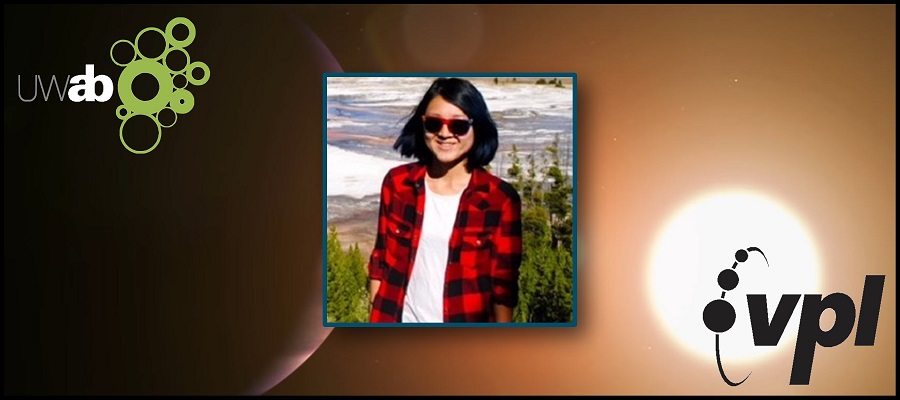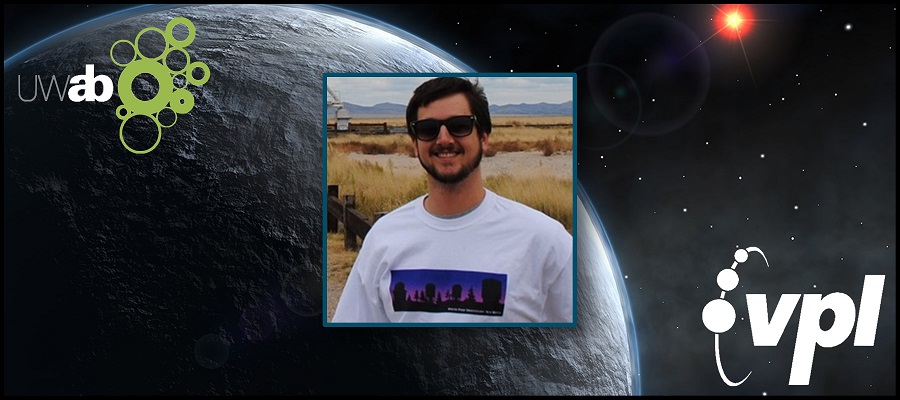VPL Postdoctoral Researcher, Andrew Lincowski (University of Washington), and VPL project PI, Victoria Meadows (University of Washington), published two new…
The observation of a 266.94 GHz feature in the Venus spectrum has been attributed to phosphine (PH3) in the Venus clouds, suggesting unexpected geological, chemical, or even biological processes. Since both PH3 and sulfur dioxide (SO2) are spectrally active near 266.94 GHz, the contribution to this line from SO2 must be determined before it can be attributed, in whole or part, to PH3. An undetected SO2 reference line, interpreted as an unexpectedly low SO2 abundance, suggested that the 266.94 GHz feature could be attributed primarily to PH3. However, the low SO2 and the inference that PH3 was in the cloud deck posed an apparent contradiction. Here we use a radiative transfer model to analyze the PH3 discovery, and explore the detectability of different vertical distributions of PH3 and SO2. We find that the 266.94 GHz line does not originate in the clouds, but above 80 km in the Venus mesosphere. This level of line formation is inconsistent with chemical modeling that assumes generation of PH3 in the Venus clouds. Given the extremely short chemical lifetime of PH3 in the Venus mesosphere, an implausibly high source flux would be needed to maintain the observed value of 20 ± 10 ppb. We find that typical Venus SO2 vertical distributions and abundances fit the JCMT 266.94 GHz feature, and the resulting SO2 reference line at 267.54 GHz would have remained undetectable in the ALMA data due to line dilution. We conclude that nominal mesospheric SO2 is a more plausible explanation for the JCMT and ALMA data than PH3.
UWAB faculty member Eric Agol and Program Director Victoria Meadows were recently interviewed by Phil LaMarr with the Universe Unplugged:…
VPL Team members Ravi Kopparapu, Giada Arney, Jacob Haqq-Misra, and Jacob Lustig-Yaeger, recently submitted a new study for publication exploring…
VPL Researcher, Eric Agol (University of Washington) is the lead author on a new study of the 7 planets in…
VPL Team member, and recent graduate from the University of Washington Astrobiology Program, Diana Windemuth (PhD Astronomy & Astrobiology, 2020),…
We present the occurrence rates for rocky planets in the habitable zones (HZs) of main-sequence dwarf stars based on the Kepler DR25 planet candidate catalog and Gaia-based stellar properties. We provide the first analysis in terms of star-dependent instellation flux, which allows us to track HZ planets. We define ?? as the HZ occurrence of planets with radii between 0.5 and 1.5 R? orbiting stars with effective temperatures between 4800 and 6300 K. We find that ?? for the conservative HZ is between ${0.37}_{-0.21}^{+0.48}$ (errors reflect 68% credible intervals) and ${0.60}_{-0.36}^{+0.90}$ planets per star, while the optimistic HZ occurrence is between ${0.58}_{-0.33}^{+0.73}$ and ${0.88}_{-0.51}^{+1.28}$ planets per star. These bounds reflect two extreme assumptions about the extrapolation of completeness beyond orbital periods where DR25 completeness data are available. The large uncertainties are due to the small number of detected small HZ planets. We find similar occurrence rates between using Poisson likelihood Bayesian analysis and using Approximate Bayesian Computation. Our results are corrected for catalog completeness and reliability. Both completeness and the planet occurrence rate are dependent on stellar effective temperature. We also present occurrence rates for various stellar populations and planet size ranges. We estimate with 95% confidence that, on average, the nearest HZ planet around G and K dwarfs is ~6 pc away and there are ~4 HZ rocky planets around G and K dwarfs within 10 pc of the Sun.
Gaussian processes (GPs) are commonly used as a model of stochastic variability in astrophysical time series. In particular, GPs are frequently employed to account for correlated stellar variability in planetary transit light curves. The efficient application of GPs to light curves containing thousands to tens of thousands of data points has been made possible by recent advances in GP methods, including the celerite method. Here we present an extension of the celerite method to two input dimensions where, typically, the second dimension is small. This method scales linearly with the total number of data points when the noise in each large dimension is proportional to the same celerite kernel and only the amplitude of the correlated noise varies in the second dimension. We demonstrate the application of this method to the problem of measuring precise transit parameters from multiwavelength light curves and show that it has the potential to improve transit parameters measurements by orders of magnitude. Applications of this method include transit spectroscopy and exomoon detection, as well a broader set of astronomical problems.
VPL scientist Dr. Ravi Kopparapu was recently awarded the NASA Exceptional Scientific Achievement Medal! NASA states: “This prestigious NASA medal…
Planetary atmospheres are inherently 3D objects that can have strong gradients in latitude, longitude, and altitude. Secondary eclipse mapping is a powerful way to map the 3D distribution of the atmosphere, but the data can have large correlations and errors in the presence of photon and instrument noise. We develop a technique to mitigate the large uncertainties of eclipse maps by identifying a small number of dominant spectra to make them more tractable for individual analysis via atmospheric retrieval. We use the eigencurves method to infer a multiwavelength map of a planet from spectroscopic secondary eclipse light curves. We then apply a clustering algorithm to the planet map to identify several regions with similar emergent spectra. We combine the similar spectra together to construct an eigenspectrum for each distinct region on the planetary map. We demonstrate how this approach could be used to isolate hot from cold regions and/or regions with different chemical compositions in observations of hot Jupiters with the James Webb Space Telescope (JWST). We find that our method struggles to identify sharp edges in maps with sudden discontinuities, but generally can be used as a first step before a more physically motivated modelling approach to determine the primary features observed on the planet.
Deputy PI and Task B Co-Lead, Giada Arney, and one of the VPL team’s resident Venus experts, was recently honored…
We use an idealized three-dimensional general circulation model to study condensible-rich atmospheres with an ineffective cold trap on slowly rotating tidally locked terrestrial planets. In particular, we show the climate dynamics in a thin and temperate atmosphere with condensible water vapor. The similarities between our thin and temperate atmosphere and the warm and thick atmosphere approaching the water vapor runaway greenhouse in previous works are discussed, including the reversal of the thermal emission between the day and night hemispheres. Different from the transit spectroscopy of water vapor that depends on the absolute amount of atmospheric water vapor, the contrast between the dayside and nightside thermal emission provides information regarding the relative ratio of water vapor to the background atmosphere as well as the atmospheric pressure near the substellar tropopause and the emission level on the nightside on potentially habitable worlds.
VPL Scientist Dr. Ravi Kopparapu (NASA GSFC) was recently featured on the Ask an Astrobiologist program! Dr. Ravi Kopparapu is…
In the present era of large-scale surveys, big data present new challenges to the discovery process for anomalous data. Such data can be indicative of systematic errors, extreme (or rare) forms of known phenomena, or most interestingly, truly novel phenomena that exhibit as-of-yet unobserved behaviours. In this work, we present an outlier scoring methodology to identify and characterize the most promising unusual sources to facilitate discoveries of such anomalous data. We have developed a data mining method based on k-nearest neighbour distance in feature space to efficiently identify the most anomalous light curves. We test variations of this method including using principal components of the feature space, removing select features, the effect of the choice of k, and scoring to subset samples. We evaluate the performance of our scoring on known object classes and find that our scoring consistently scores rare (<1000) object classes higher than common classes. We have applied scoring to all long cadence light curves of Quarters 1–17 of Kepler’s prime mission and present outlier scores for all 2.8 million light curves for the roughly 200k objects.
Giada Arney works at NASA Goddard Space Flight Center and as part of the VPL team is the Project Deputy…
Diana Windemuth (University of Washington, Advisor: Eric Agol) successfully defended their dissertation for the Dual-Title PhD in Astronomy & Astrobiology…
Are we alone in the universe? How did life arise on our planet? How do we search for life beyond…
We present self-consistent three-dimensional climate simulations of possible habitable states for the newly discovered habitable-zone Earth-sized planet TOI-700 d. We explore a variety of atmospheric compositions, pressures, and rotation states for both ocean-covered and completely desiccated planets in order to assess the planet’s potential for habitability. For all 20 of our simulated cases, we use our climate model outputs to synthesize transmission spectra, combined-light spectra, and integrated broadband phase curves. These climatologically informed observables will help the community assess the technological capabilities necessary for future characterization of this planetas well as similar transiting planets discovered in the futureand will provide a guide for distinguishing possible climate states if one day we do obtain sensitive spectral observations of a habitable planet around an M star. We find that TOI-700 d is a strong candidate for a habitable world and can potentially maintain temperate surface conditions under a wide variety of atmospheric compositions. Unfortunately, the spectral feature depths from the resulting transmission spectra and the peak flux and variations from our synthesized phase curves for TOI-700 d do not exceed 10 ppm. This will likely prohibit the James Webb Space Telescope from characterizing its atmosphere; however, this motivates the community to invest in future instrumentation that perhaps can one day reveal the true nature of TOI-700 d and to continue to search for similar planets around less distant stars.
We present the discovery and validation of a three-planet system orbiting the nearby (31.1 pc) M2 dwarf star TOI-700 (TIC 150428135). TOI-700 lies in the TESS continuous viewing zone in the Southern Ecliptic Hemisphere; observations spanning 11 sectors reveal three planets with radii ranging from 1 R ? to 2.6 R ? and orbital periods ranging from 9.98 to 37.43 days. Ground-based follow-up combined with diagnostic vetting and validation tests enables us to rule out common astrophysical false-positive scenarios and validate the system of planets. The outermost planet, TOI-700 d, has a radius of 1.19 ± 0.11 R ? and resides within a conservative estimate of the host star’s habitable zone, where it receives a flux from its star that is approximately 86% of Earth’s insolation. In contrast to some other low-mass stars that host Earth-sized planets in their habitable zones, TOI-700 exhibits low levels of stellar activity, presenting a valuable opportunity to study potentially rocky planets over a wide range of conditions affecting atmospheric escape. While atmospheric characterization of TOI-700 d with the James Webb Space Telescope (JWST) will be challenging, the larger sub-Neptune, TOI-700 c (R = 2.63 R ?), will be an excellent target for JWST and future space-based observatories. TESS is scheduled to once again observe the Southern Hemisphere, and it will monitor TOI-700 for an additional 11 sectors in its extended mission. These observations should allow further constraints on the known planet parameters and searches for additional planets and transit timing variations in the system.
We observed the 2019 January total lunar eclipse with the Hubble Space Telescope’s STIS spectrograph to obtain the first near-UV (17003200 Å) observation of Earth as a transiting exoplanet. The observatories and instruments that will be able to perform transmission spectroscopy of exo-Earths are beginning to be planned, and characterizing the transmission spectrum of Earth is vital to ensuring that key spectral features (e.g., ozone, or O3) are appropriately captured in mission concept studies. O3 is photochemically produced from O2, a product of the dominant metabolism on Earth today, and it will be sought in future observations as critical evidence for life on exoplanets. Ground-based observations of lunar eclipses have provided the Earth’s transmission spectrum at optical and near-IR wavelengths, but the strongest O3 signatures are in the near-UV. We describe the observations and methods used to extract a transmission spectrum from Hubble lunar eclipse spectra, and identify spectral features of O3 and Rayleigh scattering in the 30005500 Å region in Earth’s transmission spectrum by comparing to Earth models that include refraction effects in the terrestrial atmosphere during a lunar eclipse. Our near-UV spectra are featureless, a consequence of missing the narrow time span during the eclipse when near-UV sunlight is not completely attenuated through Earth’s atmosphere due to extremely strong O3 absorption and when sunlight is transmitted to the lunar surface at altitudes where it passes through the O3 layer rather than above it.
Jacob Lustig-Yaeger (University of Washington, Advisor: Victoria Meadows) successfully defended his dissertation for his Dual-Title PhD in Astronomy & Astrobiology…
Are we alone in the universe? How did life arise on our planet? How do we search for life beyond Earth? These profound questions excite and intrigue broad cross sections of science and society. Answering these questions is the province of the emerging, strongly interdisciplinary field of astrobiology. Life is inextricably tied to the formation, chemistry, and evolution of its host world, and multidisciplinary studies of solar system worlds can provide key insights into processes that govern planetary habitability, informing the search for life in our solar system and beyond. Planetary Astrobiology brings together current knowledge across astronomy, biology, geology, physics, chemistry, and related fields, and considers the synergies between studies of solar systems and exoplanets to identify the path needed to advance the exploration of these profound questions.
Planetary Astrobiology represents the combined efforts of more than seventy-five international experts consolidated into twenty chapters and provides an accessible, interdisciplinary gateway for new students and seasoned researchers who wish to learn more about this expanding field. Readers are brought to the frontiers of knowledge in astrobiology via results from the exploration of our own solar system and exoplanetary systems. The overarching goal of Planetary Astrobiology is to enhance and broaden the development of an interdisciplinary approach across the astrobiology, planetary science, and exoplanet communities, enabling a new era of comparative planetology that encompasses conditions and processes for the emergence, evolution, and detection of life.

